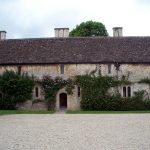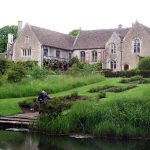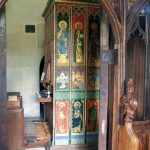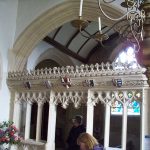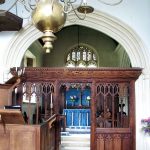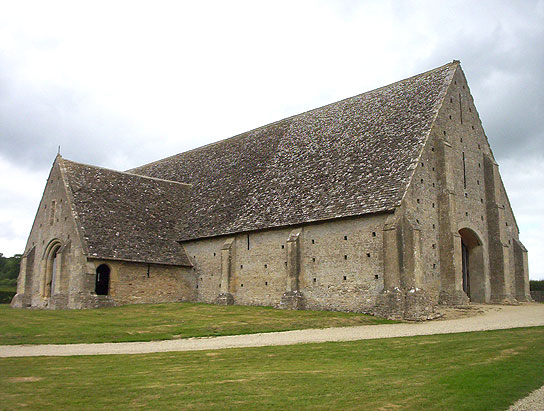
National Trust.
Great Coxwell Barn was built in the mid thirteenth century for the Cistercian abbey of Beaulieu. 152 feet long, it has buttressed walls of Cotswold stone, and a soaring stone-tiled roof with its rafters supported on slim oak timbers. Projecting porches either side of the barn house the original doors.
This is an impressive building and worth seeking out if you are in the area. The visit won’t detain you long, however.
Author: visit
Firepower – Royal Artillery Museum, Woolwich, London
The Royal Artillery Museum is hosted at the historic Royal Arsenal site beside the Thames at Woolwich. On display are a large number of guns and gun carriages ranging from medieval up to post WWII, together with exhibitions which tell the story of artillery, scientific discoveries made through warfare and human stories of courage and endeavour. The ‘Field of Fire’ audio-visual show puts visitors in the midst of battle as shells whiz overhead and guns roar. A world-class collection of artillery and associated weapons, uniforms, drawings, displays of diaries and medals records some 700 years of world artillery history.
The Royal Arsenal site itself is worth a stroll, with its wide spaces, many elegant listed buildings, and some modern outdoor sculpture. Less happy was the experience of finding Firepower still shut when it was supposed to be open. Right day? Check. Right times? Check. As a last resort I went to enquire at a café attached to the side of the building, and in the process rousted out the receptionist who didn’t seem to know what time of day it was.
The exhibits were interesting, and there was enough to look at to occupy a couple of hours or more. Building 41 with the large objects collection was not open on the date I visited, but it should be when you visit.
I travelled by train, but if you have to drive, there is a pay & display car park nearby at the Plumstead Road entrance. The Thames Barrier is not far away, and can be reached by bus.
Eltham Palace, London
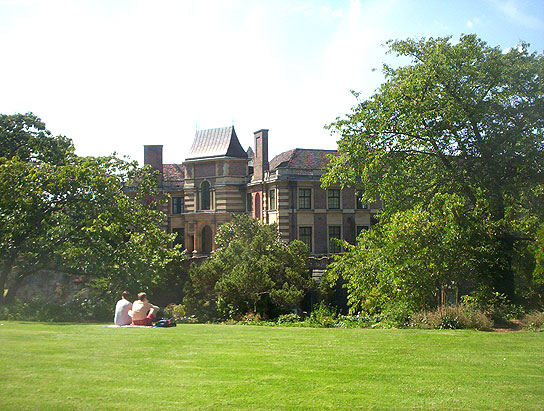
English Heritage.
There was a royal palace on the site, but all that remains is the great hall (much restored) which is incorporated into the 1935 Art Deco mansion. The Courtaulds bought a 99 year lease and demolished some old buildings (mostly not really old or interesting) before building their state-of-the-art Art Deco mansion.
It appears that no expense was spared – it’s big, and the lady liked gold plated bath taps. The Courtaulds only enjoyed their house for about 8 years, before the war and persistent near misses from sundry German munitions caused them to move to Scotland. They never returned, and the house was leased to the Army education service, who used it for half a century. English Heritage have now restored the house to its 1935 appearance, using reproductions where items had disappeared. The principal rooms, with walls and ceilings in Art Deco styles with lots of wood veneer panelling, and some inlaid marquetry pictures, are well worth seeing. There are also extensive gardens, which have been restored to something like the 1930’s appearance (but minus the swimming pool and squash court). Medieval remains can be seen in the grounds. The original 1930’s outbuildings, greenhouses, etc are around the EH car park, outside the ticketed area and a little way off the pedestrian access.
The house and gardens are well worth a visit. Not to be missed if you are a fan of Art Deco style.
I travelled here by train.
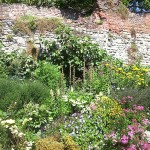
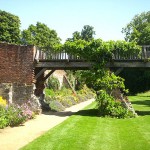
Chiswick House and Gardens, London
English Heritage.
This Roman-style Palladian villa was built for the third Earl of Burlington in the 18th century, and designed as a grand pavilion for entertaining friends and displaying art. It is considered an outstanding example of an early Palladian villa in England. Inside, it has some sumptuous interiors in the central hall and upstairs, and a collection of art. The house as seen today is stripped of any service rooms. The original ones were in the old Jacobean house, long demolished, and the replacements, attached at each side, were in use after the house was gifted to the public, but demolished sometime after WWII.
The extensive gardens are also considered of national importance. They contain walkways and vistas, and features such as a long lake, a cascade, a conservatory, walled gardens, Ionic temple, etc.
The house is well worth a visit. Externally it is an attractive building, and inside there are some impressive restored interiors, some fine paintings, and some exhibitions to look at. It is notable that there are no service rooms at all, apart from a cellar. While the surviving part was lived in at one time, it was built as a pavilion. The gardens are vast, and one can tramp around for some time finding fresh things to look at. I travelled by train.
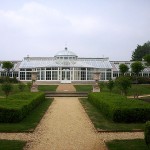
Buscot Park, Oxfordshire
National Trust.
The house is a late eighteenth-century Neo-classical building. The pavilions to each side, and the imposing flight of steps leading up to the entrance front, were added in the 1930’s. The interiors are lavish, with extravagant chandeliers, inlaid and painted Regency and Empire furniture, and mahogany doors. Many noteworthy paintings hang in the house. The more prized contents form part of the Faringdon Collection. A cycle of Burne-Jones paintings, Legend of the Briar Rose, runs around the walls of the saloon.
Outside are extensive gardens and grounds. The entrance, ticket office, walled garden and tea-room lie to the west of the house, and the Pleasure Grounds, with the larger lake and various garden features of interest lie to the east. There is a notable water garden with features leading down to the lake. Frescoes can be found in the archway leading to the (private) outdoor swimming pool, and in the tea-room.
The house interior and Faringdon Collection are well worth seeing, and the gardens provide plenty of scope for sightseeing and walking.
Opening days and dates are somewhat restricted.
Burghley House, Cambs
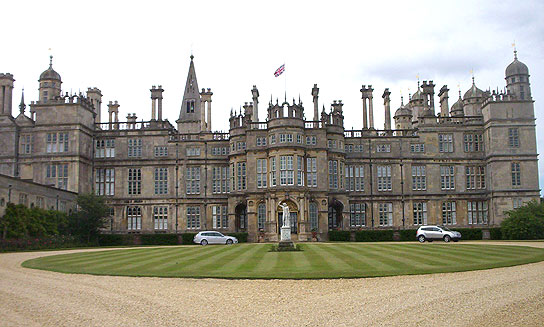 Regarded by many as the finest Elizabethan House in England, Burghley House was built in the 16th Century by William Cecil, the first Lord Burghley, Queen Elizabeth’s Lord High Treasurer. This was one of the Elizabethan “prodigy houses”. The main part of the House has 35 major rooms on the ground and first floors. There are more than 80 lesser rooms and numerous halls, corridors, bathrooms and service areas. The lead roof extends to three quarters of an acre. The historic parkland was laid out by Capability Brown. Now there are some modern visitor attractions in the grounds, including the Gardens of Surprise.
Regarded by many as the finest Elizabethan House in England, Burghley House was built in the 16th Century by William Cecil, the first Lord Burghley, Queen Elizabeth’s Lord High Treasurer. This was one of the Elizabethan “prodigy houses”. The main part of the House has 35 major rooms on the ground and first floors. There are more than 80 lesser rooms and numerous halls, corridors, bathrooms and service areas. The lead roof extends to three quarters of an acre. The historic parkland was laid out by Capability Brown. Now there are some modern visitor attractions in the grounds, including the Gardens of Surprise.
When one arrives in the car park, through the trees one has a quite impressive view of the house. However this is just the stables and the side of the service wing! The house itself as befits one of the Elizabethan “prodigy houses” is very big, on 4 floors, with scores of windows, turrets, chimneys, spires etc. It’s very impressive. Inside there is lots to see, with approx 18 principal rooms on the first floor all equipped with paintings, furniture and a cornucopia of treasures. There are also exhibitions of treasures by the ticket office which are worth a look.
Outside there is a park, and gardens. The “Gardens of Surprise” has quirky water fountains and other features (great for children). I particularly liked the Fire/Air/Water/Earth sculptures where one presses a button and they change shape or (for Fire) emit smoke. Next to that is the Sculpture garden – a large wooded area with exhibits of modern sculpture dispersed through it. The lake had orange things floating in it which I’m almost sure were sculptures. For refreshments, the Orangery restaurant looked expensive but the garden cafe is cheaper.
There is much to see and do at Burghley, so that one could make it an all-day visit.
Access to the house is via the main street of the old town of Stamford, where the Classical and Georgian townscape has survived almost unscathed. (Visited 17/07/11)
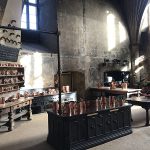
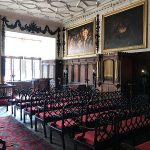
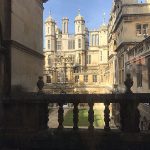
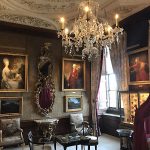
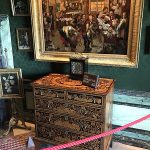
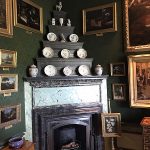
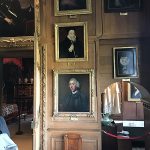
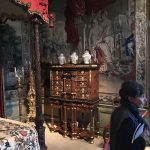
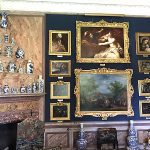
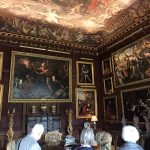

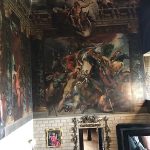
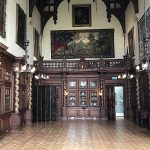
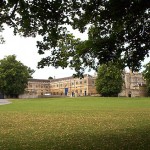
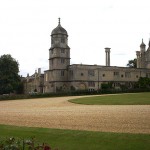
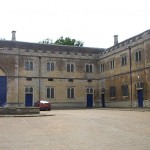
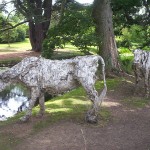
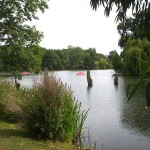
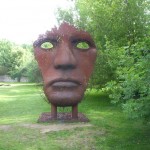

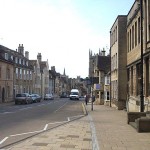
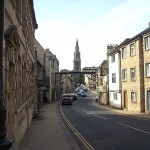
The National Museum of Computing, Bletchley, Bucks
The National Museum of Computing is dedicated to showing the development of computing in its broadest sense, from the pioneering wartime efforts that resulted in Colossus, to the products and systems we use today. Exhibits include the Colossus replica, and some big-iron commercial computers e.g Elliot 803B, ICL 2966, that formerly filled the computer rooms of large companies from the 1960s to the 1980s, and a multitude of personal computers and calculators, including Sinclair, BBC Micro, and Amstrad.
There should be something here to interest everyone who has used computers. Older visitors can go around exclaiming “I used to use one of those!” while younger ones can try out the computer games on the personal computers.
TNMOC is on the same site as Bletchley Park, in block H. Please note that TNMOC now levies an admission charge of £5, and if you only want to visit TNMOC, you don’t need to pay the Bletchley Park admission as well. Currently TNMOC has restricted opening hours.
Bletchley Park, Bucks
The WWII code-breaking centre at Bletchley Park was a well-kept secret for years. When the fact of its existence was de-classified, the buildings on the site became the object of attention, and eventually a Trust was set up to preserve the more noteworthy buildings, establish a museum of codebreaking and explain the significance of what went on at the site. Here, the German Enigma code was broken. During the war, thousands of people were employed here, and there was cutting-edge work in developing machine aids for decryption. The electromechanical “Bombe” was invented to help crack Enigma and the electronic computer “Colossus” was invented to help crack the more difficult “Tunny” teleprinter code.
If you visit, there is a lot to see, and one day might not be enough. Guided tours of the various buildings are available, taking in the Mansion, (an opulent if rather mongrel Edwardian mansion), various brick out-buildings of the mansion, some near-indestructible bomb-proofed concrete huts, and some decaying wooden huts with famous numbers, as well as Bombe and Colossus reconstructions.
Then there is the Museum of Codebreaking, where you can try to get your head around how decrypting Enigma actually worked, and other huts with displays about spies, daily life at Bletchley Park during the war, and so forth. Did you know that British military planes used to carry a pigeon so that the bird could carry a message back if the plane came down? I didn’t.
In addition there are other historic displays that share the Bletchley Park site, from TNMOC – the National Museum of Computing, the cine projector museum with mini cinema and newsreel shows, the display of ship models, and others. These ‘other’ groups have their own opening times – check websites.
There is also a series of lectures, which explore war and codebreaking topics in some depth.
Also, there is a miscellany of Events, seemingly ranging from parades of military vehicles to almost anything else.
If you are interested in history, war, or codebreaking, you should find something to interest you here.
Bletchley Park is open daily, but this does not apply to associates such as TNMOC, so check before travelling. Parts of the mansion may be in use for commercial activities on any day except Sundays.
Bletchley Park admission is not expensive considering the amount to be seen, and permits repeated re-admission for 12 months.
Please note that there is a £3 charge for parking in the grounds. Bletchley Park entrance is about 100 yards from Bletchley railway station.
Apsley House, London
English Heritage.
Apsley House was originally designed and built by Robert Adam between 1771 and 1778 for Baron Apsley. Later, it was owned by Richard Wellesley and then by his younger brother Arthur Wellesley – the Duke of Wellington. Wellington is best known for defeating Napoleon at the Battle of Waterloo, but he was also a major politician, who rose to become Prime Minister in 1828. Apsley House was redesigned to reflect Wellesley’s rising status, and its dazzling interiors are prime examples of British grandeur in the Regency style. Inside Apsley House are many objects relating to the Duke’s life and work, including his art collection, some of it collected on campaign, a giant statue of Napoleon, a huge silver-gilt dining table centerpiece, and a whole room full of trophies donated by grateful nations.
With all that opulence on display, there is plenty to look at inside Apsley House. It’s more of a palace than a house, in fact. The exhibitions in some of the rooms are quite informative about Wellesley’s career.
Hyde Park Corner underground station is adjacent to the house. Don’t even think of trying to go there by car. On the traffic island in front of the house is the Wellington Arch (see separate entry), and an assortment of statues and monuments which are worth a look while you’re there.
While here, I also visited the actual Marble Arch, reached by a bracing walk along the edge of Hyde Park. This three-arch white marble monument is worth a look, but you can’t go inside.
Great Chalfield Manor, Wiltshire
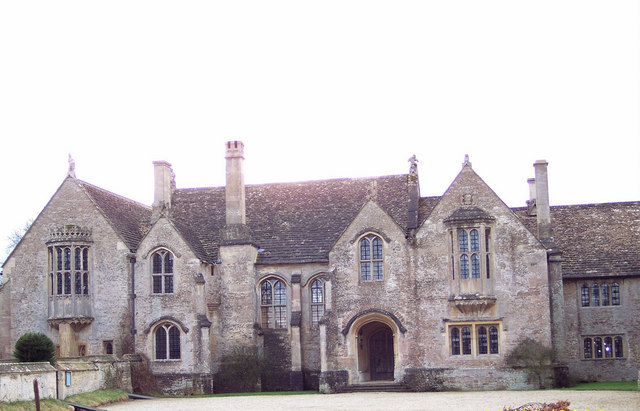 National Trust.
National Trust.
Great Chalfield Manor was built in 1467-80. Following centuries of neglect, which left it in a ruinous and partly demolished state, it was restored in 1905-12 for the Fuller family. A century later, it becomes harder to tell which bits are original and which are reconstructed. The house is furnished with period furniture collected by the Fullers. Outside are moats, lawns, and a working estate.
Inside the house are some interesting features. An ancient mural uncovered in the dining room is thought to be of the first owner, Tropnell. High up in the great hall are heads thought to be medieval caricatures. The garden has two large pieces of topiary with cross-passages, and a summerhouse in one corner.
(Picture: Trish Steel – Wikimedia)
